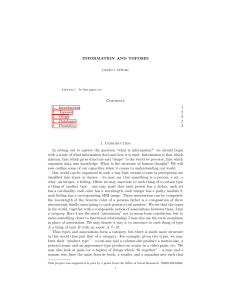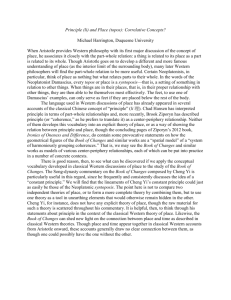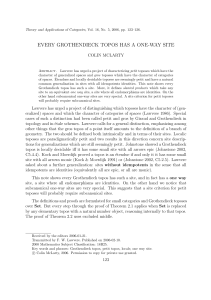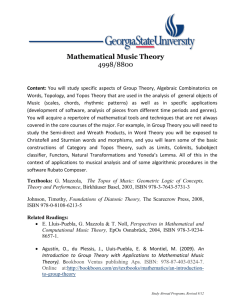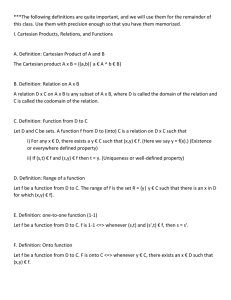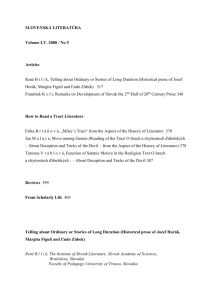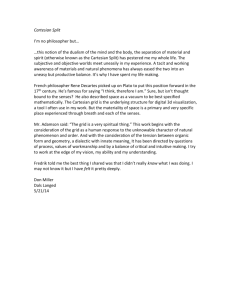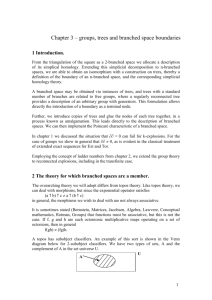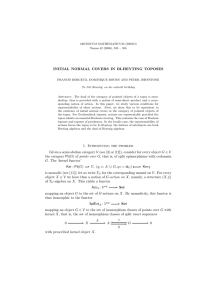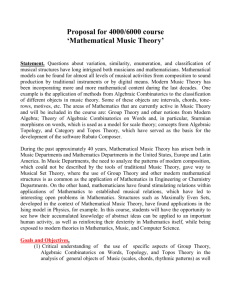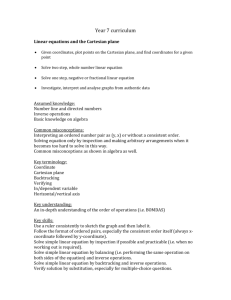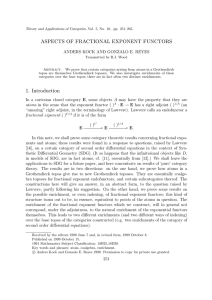PARTIAL TOPOSES JEAN B´ ENABOU AND THOMAS STREICHER
advertisement
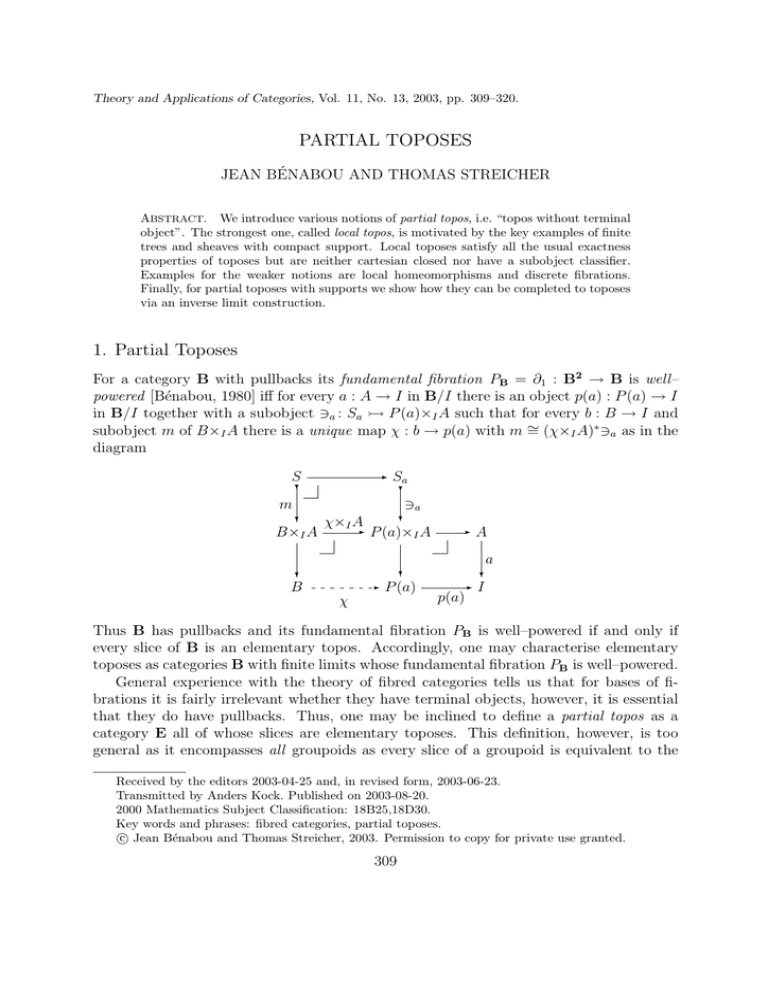
Theory and Applications of Categories, Vol. 11, No. 13, 2003, pp. 309–320.
PARTIAL TOPOSES
JEAN BÉNABOU AND THOMAS STREICHER
ABSTRACT. We introduce various notions of partial topos, i.e. “topos without terminal
object”. The strongest one, called local topos, is motivated by the key examples of finite
trees and sheaves with compact support. Local toposes satisfy all the usual exactness
properties of toposes but are neither cartesian closed nor have a subobject classifier.
Examples for the weaker notions are local homeomorphisms and discrete fibrations.
Finally, for partial toposes with supports we show how they can be completed to toposes
via an inverse limit construction.
1. Partial Toposes
For a category B with pullbacks its fundamental fibration PB = ∂1 : B2 → B is well–
powered [Bénabou, 1980] iff for every a : A → I in B/I there is an object p(a) : P (a) → I
in B/I together with a subobject a : Sa P (a)×I A such that for every b : B → I and
subobject m of B×I A there is a unique map χ : b → p(a) with m ∼
= (χ×I A)∗ a as in the
diagram
?
- Sa
?
?
?
S
m
B×I A
χ×I A
P (a)×I A
?
?
B
a
χ
- P (a)
-A
a
?
-I
p(a)
Thus B has pullbacks and its fundamental fibration PB is well–powered if and only if
every slice of B is an elementary topos. Accordingly, one may characterise elementary
toposes as categories B with finite limits whose fundamental fibration PB is well–powered.
General experience with the theory of fibred categories tells us that for bases of fibrations it is fairly irrelevant whether they have terminal objects, however, it is essential
that they do have pullbacks. Thus, one may be inclined to define a partial topos as a
category E all of whose slices are elementary toposes. This definition, however, is too
general as it encompasses all groupoids as every slice of a groupoid is equivalent to the
Received by the editors 2003-04-25 and, in revised form, 2003-06-23.
Transmitted by Anders Kock. Published on 2003-08-20.
2000 Mathematics Subject Classification: 18B25,18D30.
Key words and phrases: fibred categories, partial toposes.
c Jean Bénabou and Thomas Streicher, 2003. Permission to copy for private use granted.
309
310
JEAN BÉNABOU AND THOMAS STREICHER
terminal category 1 and, therefore, is a trivial topos. Thus, there arises the question
which conditions are missing in order to rule out such degenerate examples.
First observe that a category B has pullbacks iff for every morphism α : J → I in B
the functor Σα : B/J → B/I : β → α◦β has a right adjoint α∗ , i.e., as shown in [Bénabou,
1980], that change of base for fibrations along Σα preserves smallness of fibrations. Thus,
B has pullbacks iff for all morphisms α in B change of base along Σα preserves1 all good
properties of fibrations as the Σα do preserve pullbacks anyway. From this point of view
it appears as most natural to further require that for all objects I ∈ B the change of
base along ΣI = ∂0 : B/I → B (i.e. localisation to I) preserves all good properties of
fibrations. As the ΣI do preserve pullbacks anyway this requirement boils down to the
condition that all ΣI have a right adjoint I ∗ : B → B/I, i.e. that B has binary products2 .
These considerations should motivate the relevance of the following notion.
1.1. Definition. A partial cartesian category is a category with pullbacks and binary
products, i.e. a category with finite non–empty limits.
All partial cartesian groupoids are trivial for the following reason.
1.2. Lemma.
Every groupoid G with binary products is trivial.
Proof. First of all notice that a groupoid G with binary products is strongly connected
in the sense that for all X, Y ∈ G there is a morphism from X to Y as we have π1 :
X × Y → X and π2 : X × Y → Y and, therefore, π2 ◦ π1−1 : X → Y . Moreover, G
is posetal as for morphisms f, g : X → Y we have f, g = δY ◦ h = h, h for some
h : X → Y because δY = idY , idY is an isomorphism.
Notice that we could have defined the notion of “partial cartesian category” equivalently as a category B with binary products all of whose slices are cartesian as the latter
requirement is equivalent to the existence of all pullbacks. Notice that for all α : J → I
in B the pullback functor α∗ : B/I → B/J preserves finite limits. Moreover, if B/I and
B/J are cartesian closed or toposes then α∗ : B/I → B/J preserves exponentials and
subobject classifiers, i.e. all structure under consideration.
This suggests the following notions of “partial locally cartesian closed category” and
“partial topos”.
1.3. Definition. A partial locally cartesian closed category is a category with binary
products all of whose slices are cartesian closed. A partial topos is a category with binary
products all of whose slices are toposes.
1
It has been shown in [Bénabou, 1980] that change of base along a functor F between categories with
pullbacks preserves all good properties of fibrations if and only if F preserves pullbacks and has a right
adjoint.
2
For objects I and J in B their product cone is given by I ∗ J : P → I and the counit εJ : P → J of
ΣI I ∗ at J.
PARTIAL TOPOSES
311
It is a straightforward exercise to show that B is partial cartesian closed if and only
if B has binary products and PB = ∂1 : B2 → B is locally small.
Partial toposes have conditional colimits in the following sense.
1.4. Lemma.
cocone.
In a partial topos every finite diagram has a colimit whenever it has a
Proof. Let E be a partial topos. A cocone for a finite diagram D : D → E corresponds
uniquely to a diagram DA : D → E/A which has a colimit in the topos E/A. Moreover,
the functor ΣA = ∂0 : E/A → E preserves all colimits as it has a right adjoint. Thus,
applying ΣA to a colimiting cocone for DA gives rise to a colimiting cocone for D as
required.
Thus, in particular, for partial toposes the situation is as follows.
1.5. Corollary.
For a partial topos E we have that
(1) E has an initial object if and only if E is nonempty.
(2) The sum X + Y exists in E if and only if there are morphism X → Z and Y → Z
in E for some object Z in E.
(3) A parallel pair of maps f, g : X → Y in E has a coequaliser if and only if h◦f = h◦g
for some h : Y → Z in E.
Proof. Obvious from Lemma 1.4.
Next we discuss a few examples of properly partial toposes, i.e. partial toposes without
a terminal object3 .
1.6. Example. For a topos E and a set I of subterminals, i.e. subobjects of 1E let E/I
be the full subcategory of E on those objects X for which there is a morphism from X to
some U ∈ I. One easily checks that E/I is always a partial topos and that it is a topos
iff I has a greatest element. The next three examples are instances of this quite general
scheme.
1.7. Example.
Let FinSet be the category of finite sets and arbitrary maps. The
op
category of finitely branching trees is given by FinSetω , i.e. presheaves on ω with values
in FinSet. It is a topos as ω/n is finite for all n ∈ ω. Let I be the set of all proper
subobjects of the terminal object, i.e. all presheaves isomorphic to ∂0 : ω/n → ω for some
op
n ∈ ω. Then T = FinSetω/I , the category of finite trees, is a properly partial topos as I
does not have a greatest element.
3
Obviously, a partial topos is a topos iff it has a terminal object.
312
JEAN BÉNABOU AND THOMAS STREICHER
1.8. Example.
The category of Set–valued presheaves over the large poset Ord of
ordinals is a topos as Ord/α is a set for all α ∈ Ord. Let Wrk be the full subcategory on
those presheaves A whose support is a set, i.e. for which there is an α ∈ Ord such that
A(β) = ∅ for all β > α.
1.9. Example. Let X be a locally compact Hausdorff space and I the set of subterminals
in Sh(X) consisting of the relatively compact open subsets of X, i.e. those open U ⊆ X
whose closure U is compact in X. Then Shc (X) = Sh(X)/I , the category of sheaves on X
“with compact support”, is a partial topos which is properly partial iff X is not compact.
1.10. Example. Let LH be the category of spaces and local homeomorphism. It can
be shown that LH has binary products (see [Selinger, 1994]). Thus, LH is a partial topos
as for every space X the slice of LH over X is equivalent to the topos Sh(X). It follows
from Lemma 2.2 below that LH does not have a terminal object.
1.11. Example. Let dF be the category of small categories and discrete fibrations as
morphisms. It can be shown that dF has binary products (the proof is a variation of
Selinger’s proof in [Selinger, 1994] that LH has binary products). Thus, dF is a partial
topos as for every small category C the slice of dF over C is equivalent to the presheaf
= SetCop . It follows from Lemma 2.2 below that dF does not have a terminal
topos C
object.
We conclude this section by showing that partial cartesian categories cannot have
exponentials or a subobject classifier unless they have already a terminal object, i.e. are
properly cartesian.
1.12. Lemma. Let B be a partial cartesian category. If for some object A in B the
exponential AA exists in B then B has a terminal object, namely the equalizer of the
identity on AA and the morphism r : AA → AA defined as the exponential transpose of
π2 : AA × A → A.
Proof. Let e : T AA be an equalizer of idAA and r. Observe that a map f : B → AA
equalizes idAA and r iff ev ◦ (f × A) = ev ◦ (r × A) ◦ (f × A), i.e. iff ev ◦ (f × A) =
π2 ◦ (f × A) = π2 . Thus, for every object B in B there exists precisely one map from B
to AA equalizing idAA and r. Accordingly, for every object B in B there exists precisely
one map from B to T , i.e. T is terminal in B as claimed.
1.13. Lemma. Let B be a partial cartesian category with a subobject classifier t : T Ω.
Then T is terminal in B.
PARTIAL TOPOSES
313
Proof. For every object A of B let A : A → Ω be the classifier of idA . Notice that
for f : B → A we have A ◦ f = B . Let p : Ω → T be the unique map with t ◦ p = Ω .
We have t ◦ p ◦ t = Ω ◦ t = T = t from which it follows that p ◦ t = idT . Thus, the
monomorphism t is an equalizer for idΩ and Ω . Obviously, a map f : A → Ω equalizes
idΩ and Ω iff f = Ω ◦ f = A . Thus, for every object A of B there exists precisely one
map from A to T , i.e. T is terminal in B as claimed.
2. Partial Toposes with Supports
Now we will discuss some further property of partial toposes satisfied by all the examples
above with the exception of Examples 1.10 and 1.11.
2.1. Definition. Let B be a category. An object U ∈ B is called subterminal if for all
objects X ∈ B there exists at most one morphism in B from X to U . We write st(B) for
the full subcategory of B on subterminal objects of B and say that B is a category with
supports or has supports iff the inclusion i : st(B) → B has a left adjoint supp.
Obviously, the category st(B) is posetal as for subterminals U and V there is at most
one arrow from U to V . Accordingly, we write U ≤ V iff there is an arrow from U to V .
Notice, moreover, that in a category with a terminal object the subterminals in the sense
of the previous definition coincide with the subobjects of the terminal object.
Obviously, for U ∈ st(B) it leads to no confusion when identifying B/U with the full
subcategory of B on those objects X for which there is a morphism X → U in B. Hence,
in the sequel we employ this harmless identification whenever convenient.
For partial cartesian categories B with supports Lemmas 1.12 and 1.13 can be shown
even more easily as follows. If AA exists in B then for all objects B in B there is a
map from B to AA (the exponential transpose of π2 : B × A → A) and accordingly
supp(B) ≤ supp(AA ) from which it follows that supp(AA ) is terminal in B. If there is a
subobject classifier t : T Ω in B then for all objects B in B there is a map from B
to Ω (the classifier of idB ) and accordingly supp(B) ≤ supp(Ω) from which it follows that
supp(Ω) is terminal in B.
The next lemma shows that not every partial topos has supports.
2.2. Lemma. Both in LH and dF there are objects X such that there is no map from
X to a subterminal object U .
Proof. First notice that up to isomorphism the monos in LH are the open subspace
inclusions. Let ∇(2) be the codiscrete space with 2 elements. The space ∇(2) cannot be
subterminal as it admits endomaps different from id∇(2) . As every local homeomorphism
h : ∇(2) → X must have discrete fibres it follows that h is one–to–one, i.e. monic and,
therefore, isomorphic to a subspace inclusion. Thus, if there were a map h : ∇(2) → U
314
JEAN BÉNABOU AND THOMAS STREICHER
with U subterminal then ∇(2) were subterminal, too. Thus, there is no map from ∇(2)
to a subterminal object.
First notice that up to isomorphism the monos in dF are inclusions of sieves. Let ∇(2)
be the codiscrete category with 2 elements. The category ∇(2) cannot be subterminal as
it admits endomaps different from id∇(2) . As every discrete fibration P : ∇(2) → X must
have discrete fibres it follows that P is isomorphic to a sieve inclusion and, therefore, a
monomorphism. Now if P : ∇(2) → B were a discrete fibration with B subterminal then
∇(2) were subterminal, too. Thus, there is no map from ∇(2) to a subterminal object.
Obviously, from Lemma 2.2 it follows that LH and dF have neither supports nor a
terminal object.
Notice that already for the space R of real numbers there cannot exist a reflection map
ηR from R to a subterminal U . The reason is that for every c ∈ R the map f (x) = c + x
is an automorphism of R from which it follows that ηR : R → U has to be constant and,
therefore, cannot be a local homeomorphism as it has a non-discrete fibre, namely R.
There is also another argument showing that dF is not a category with supports.
First observe that for a subterminal object B in dF it holds that objects I, J ∈ B are
isomorphic whenever B/I ∼
= B/J. Let C be the category
A
α-
β
T B
where the objects A, B and T are all different. We show that for every discrete fibration
P : C → B the category B cannot be subterminal. The objects P (A) and P (B) are not
isomorphic as otherwise there were a map from A to B in C. But on the other hand we
have
B/P (A) ∼
= C/A ∼
=1∼
= C/B ∼
= B/P (B)
from which it follows by the above observation that P (A) and P (B) are isomorphic in B.
Thus, the category B cannot be subterminal in dF and, accordingly, in dF there is no
map from C to a subterminal object. From this it follows that dF has neither supports
nor a terminal object.
Next we show how under the assumption of having supports partial cartesian categories
can be characterised more simply.
2.3. Lemma.
Let B be a category with supports and pullbacks. Then B has binary
products if and only if st(B) has binary infima.
Proof. Assume that B has supports and pullbacks.
If B has binary products then st(B) has binary infima as subterminals are closed under
binary products.
315
PARTIAL TOPOSES
On the other hand if st(B) has binary infima then the binary product of A and B is
constructed as follows
A×B
p1
?
A
?
m1
p2 -
B -
m2-
B
?
?
- U ∩ V- - V
?
?
?
- U
A
where U = supp(A), V = supp(B) and U ∩ V is the infimum of U and V in st(B). The
projections πi are given by mi ◦ pi as indicated in the diagram.
We have already observed that most examples of partial toposes satisfy the additional
property of having supports. In the Examples 1.7–1.9 it holds moreover that the subcategory of subterminals is filtered in the sense that for all subterminals U and V there is a
subterminal W with U, V ≤ W .
Next we show that categories B with supports and pullbacks have binary products
whenever st(B) is filtered.
2.4. Lemma. Let B be a category with pullbacks and supports where st(B) is filtered, i.e.
for all U, V ∈ st(B) there is a W ∈ st(B) with U, V ≤ W . Then B has binary products.
Proof. By Lemma 2.3 it suffices to show that st(B) has binary infima. Suppose U
and V are in st(B). As st(B) is filtered there is a W in st(B) with U, V ≤ W . Then the
infimum of U and V is given by the pullback
U ∩V
?
U
-V
?
-W
The object U ∩ V is subterminal as for every object X there is at most one arrow from X
to U ∩ V (because there is at most one arrow from X to U and at most one arrow from
X to V ).
In the light of the previously considered examples the following more restrictive notion
of partial topos seems to be also the more useful one.
2.5. Definition. A category E is called a local topos iff the following three conditions
hold
(1) every slice of E is a topos
316
JEAN BÉNABOU AND THOMAS STREICHER
(2) the inclusion i : st(E) → E has a left adjoint supp
(3) the category st(E) is filtered, i.e. for all U, V ∈ st(B) there is a W ∈ st(B) with
U, V ≤ W .
Notice that for partial toposes E/I as in Example 1.6 their categories of subterminals
are filtered if and only if I is filtered. This, however, need not be the case as e.g. if
E = SetI for some infinite set I and I is given by all subsets of I having at most n
elements (for a finite cardinal n fixed in advance).
We conclude this section by observing that most of the exactness properties of toposes
extend to local toposes.
From Lemma 1.4 it follows that finite colimits exists (as filtered supports guarantee
that every finite diagram has a cocone). Moreover, finite colimits are preserved by pullbacks as every slice is a topos and in toposes colimits are preserved by pullbacks. For
the same reason a morphism is epic iff it is a coequaliser (of its kernel pair) and monos
are preserved by pushouts along arbitrary morphism and such pushout squares are also
pullback squares. Furthermore, all local toposes are extensive categories with pullbacks
because they have finite sums and all its slices are extensive as they are toposes. Moreover,
all properties of internal categories, functors and distributors (as studied in [Johnstone,
1977]) are valid also for local toposes. Finally, notice that all partial toposes are locally
cartesian closed, i.e. all pullback functors f ∗ have right adjoints Πf satisfying the (Beck-)
Chevalley condition. Thus, fibred over itself every partial topos has internal products (see
[Bénabou, 1980, Streicher, 2003]).
3. Topos Completion of Partial Toposes with Supports
Now we will show how to complete a partial topos E with supports to a topos E∞ . For
the rest of this section all partial toposes are assumed to have supports.
Notice that for every map i : U → V between subterminals for the induced essential
geometric morphism
Σi i∗ Πi : E/U → E/V
it holds that i∗ is logical and its adjoints are full and faithful.
We write E/(−) for the contravariant (pseudo-)functor from st(E) to the (2-)category
Log of toposes and logical morphisms sending U to E/U and i : U → V to the logical
functor i∗ : E/V → E/U .
3.1. Theorem.
Let E be a partial topos with supports and
E∞ = LimU ∈st(E) E/U
the inverse limit of E/(−) : st(E)op → Log called topos completion of E.
Then for every U ∈ st(E) the projection πU : E∞ → E/U is equivalent to U ∗ : E∞ →
E/U and has full and faithful left and right adjoints ΣU and ΠU , respectively.
PARTIAL TOPOSES
317
Moreover, st(E) can be embedded into st(E∞ ) by sending U ∈ st(E) to ι(U ) = (U ∩
V )V ∈st(E) . Then E can be recovered up to equivalence from E∞ as E∞/st(E) where st(E) is
considered as included into st(E∞ ) via ι.
Proof. We first give a more detailed description of the inverse limit E∞ = LimU ∈st(E) E/U .
Its objects are cartesian sections of the fibration corresponding to the pseudo-functor
E/(−) : st(E)op → Log. More explicitly, an object of E∞ is a function A picking an
object AU ∈ E/U for every U ∈ st(E) and a (mono)morphism AV,U : AV → AU with
AV,U
AV - - AU
?
V-
?
- U
for every pair V ≤ U in st(E) in a functorial way, i.e. satisfying AU,U = idAU and AV,U ◦
AW,V = AW,U whenever W ≤ V ≤ U . For A, B ∈ E∞ a morphism from A to B is given
by a family (fU : AU → BU )U ∈st(E) such that
AV,U
AV - - AU
fV
fU
? B
?
V,U
BV - - BU
?
V-
?
-U
whenever V ≤ U .
It is evident that E∞ has finite limits which are constructed componentwise. A (canonical) terminal object 1 in E∞ for example is given by 1U = U and 1V,U the unique morphism
from V to U in E.
For A, B ∈ E∞ their exponential B A is constructed by putting (B A )U = BU AU
(exponential in E/U ) and for V ≤ U the map (B A )V,U : BV AV → BU AU is given
where ev
: BV AV × AU → BV is the unique map with
as the transpose of BV,U ◦ ev
◦ (B V AV × AV,U ) = ev : BV AV × AV → BV as in the diagram
ev
BV AV × AV
BV
AV
× AV,U
BV
Thus E∞ is cartesian closed.
AV
∼
=
?
× AU
BV,U
ev BV - - BU
-
ev
318
JEAN BÉNABOU AND THOMAS STREICHER
A subobject classifier Ω in E∞ can be constructed by choosing for every U ∈ st(E)
a generic mono tU : 1U → ΩU in E/U and then defining for V ≤ U in st(E) the map
ΩV,U : ΩV → ΩU as the unique morphism in E/U satisfying
- 1U
1V tV
tU
?
ΩV -
?
- ΩU
ΩV,U
from which definition it is clear that ΩU,U = idΩU and ΩW,U = ΩV,U ◦ ΩV,U as
1W-
- 1V -
tW
- 1U
tV
?
ΩW-
tU
?
- ΩV -
ΩW,V
?
- ΩU
ΩV,U
whenever W ≤ V ≤ U in st(E). That ΩV,U fits into a pullback diagram
ΩV -
ΩV,U -
?
V-
ΩU
?
-U
i = 1V,U
can be seen as follows. As i∗ : E/U → E/V is a logical functor it in particular preserves
subobject classifiers. Thus, we have
1V
tV
∼
=-
i∗ 1U- - 1U
i∗ tU
tU
? m
? χ
?
ΩV - i∗ ΩU- - ΩU
∼
=
-
?
V-
i
?
- U
The map χ is an isomorphism because i∗ tU is a subobject classifier in E/V as i∗ is logical.
Thus, we have ΩV,U = m ◦ χ form which the claim follows.
This finishes the proof that E∞ is a topos.
One easily sees that the projection πU : E∞ → E/U is equivalent to the logical functor
∗
U : E∞ → E∞ /U E/U . One can embed E into E∞ via a functor I sending A ∈ E to
PARTIAL TOPOSES
319
I(A) ∈ E∞ where I(A)U = A × U and I(A)V,U = A × iV,U as illustrated in the diagram
A × iV,U
- A×U
A × Vπ2
π2
?
V-
?
iV,U
-U
and f : A → B in E to I(f ) : I(A) → I(B) with I(f )U = f × U . The functor U ∗ has a
full and faithful left adjoint ΣU equivalent to the restriction of I to E/U . As U ∗ is logical
and has a full and faithful left adjoint it follows that U ∗ has also a right adjoint ΠU which
is also full and faithful.
Obviously, the the restriction of I to st(E) factors through st(E∞ ) and is equivalent
to ι : E → E∞ : U → (U ∩V )V ∈st(E) as U × V ∼
= U ∩ V for subterminals U, V . Thus, we
have E/U E∞ /ι(U ) for every U ∈ st(E) from which it follows that E E∞/st(E) as
desired.
Notice that for defining the embedding I : E → E∞ we have used essentially that E
has supports and binary products.
We observe that applying the topos completion procedure of Theorem 3.1 to the
partial toposes of the Examples 1.7–1.9 gives rise to the toposes from which they are were
op
op
constructed, i.e. T∞ FinSetω , Wrk∞ SetOrd and Shc (X)∞ Sh(X) for locally
compact Hausdorff spaces X.
Finally we want to remark that the topos completion procedure of Theorem 3.1 extends
to NNOs (Natural Numbers Objects) in the following way. If E is a partial topos such
that for every U ∈ st(E) there is a NNO
zU-
U
sU-
NU
NU
in E/U then these can be organised into a single NNO in E∞ choosing for V ≤ U the
map NV,U : NV → NU as the unique arrow making the diagram
V-
- U
zV
?
NV -
sV
zU
?
- NU
NV,U
?
NV -
sU
?
- NU
NV,U
commute. Existence and uniqueness of NV,U follows from the fact that the pullback
functor V ∗ : E/U → E/V preserves NNOs.
320
JEAN BÉNABOU AND THOMAS STREICHER
Acknowledgements.
We acknowledge the use of Paul Taylor’s diagram macros used for writing this paper.
References
J. Bénabou (1980) Des Catégories Fibrées lecture notes by J.-R. Roisin of a course at
Univ. Louvain-la-Neuve.
P. T. Johnstone (1977) Topos Theory Academic Press.
P. Selinger (1994) LH has nonempty products unpublished note, electronically available
at http://quasar.mathstat.uottawa.ca/˜selinger/papers/ lh.ps.gz
T. Streicher (2003) Fibred Categories à la J. Bénabou extended version of lecture
notes for a course given in Munich in April 1999, electronically available at
http://www.mathematik.tu-darmstadt.de/˜streicher/FIBR/FibLec.ps.gz
20 rue Lacépède,
F-75005, Paris, France
FB4 Mathematik, TU Darmstadt,
Schloßgartenstr.7,
D-64289, Germany
Email: jean.benabou@wanadoo.fr
streicher@mathematik.tu-darmstadt.de
This article may be accessed via WWW at http://www.tac.mta.ca/tac/ or by anonymous ftp at ftp://ftp.tac.mta.ca/pub/tac/html/volumes/11/13/11-13.{dvi,ps}
THEORY AND APPLICATIONS OF CATEGORIES (ISSN 1201-561X) will disseminate articles that
significantly advance the study of categorical algebra or methods, or that make significant new contributions to mathematical science using categorical methods. The scope of the journal includes: all areas of
pure category theory, including higher dimensional categories; applications of category theory to algebra,
geometry and topology and other areas of mathematics; applications of category theory to computer
science, physics and other mathematical sciences; contributions to scientific knowledge that make use of
categorical methods.
Articles appearing in the journal have been carefully and critically refereed under the responsibility
of members of the Editorial Board. Only papers judged to be both significant and excellent are accepted
for publication.
The method of distribution of the journal is via the Internet tools WWW/ftp. The journal is archived
electronically and in printed paper format.
Subscription information. Individual subscribers receive (by e-mail) abstracts of articles as
they are published. Full text of published articles is available in .dvi, Postscript and PDF. Details will
be e-mailed to new subscribers. To subscribe, send e-mail to tac@mta.ca including a full name and
postal address. For institutional subscription, send enquiries to the Managing Editor, Robert Rosebrugh,
rrosebrugh@mta.ca.
Information for authors. The typesetting language of the journal is TEX, and LATEX is the
preferred flavour. TEX source of articles for publication should be submitted by e-mail directly to an
appropriate Editor. They are listed below. Please obtain detailed information on submission format and
style files from the journal’s WWW server at http://www.tac.mta.ca/tac/. You may also write to
tac@mta.ca to receive details by e-mail.
Editorial board.
John Baez, University of California, Riverside: baez@math.ucr.edu
Michael Barr, McGill University: barr@barrs.org, Associate Managing Editor
Lawrence Breen, Université Paris 13: breen@math.univ-paris13.fr
Ronald Brown, University of Wales Bangor: r.brown@bangor.ac.uk
Jean-Luc Brylinski, Pennsylvania State University: jlb@math.psu.edu
Aurelio Carboni, Università dell Insubria: aurelio.carboni@uninsubria.it
Valeria de Paiva, Palo Alto Research Center: paiva@parc.xerox.com
Martin Hyland, University of Cambridge: M.Hyland@dpmms.cam.ac.uk
P. T. Johnstone, University of Cambridge: ptj@dpmms.cam.ac.uk
G. Max Kelly, University of Sydney: maxk@maths.usyd.edu.au
Anders Kock, University of Aarhus: kock@imf.au.dk
Stephen Lack, University of Western Sydney: s.lack@uws.edu.au
F. William Lawvere, State University of New York at Buffalo: wlawvere@buffalo.edu
Jean-Louis Loday, Université de Strasbourg: loday@math.u-strasbg.fr
Ieke Moerdijk, University of Utrecht: moerdijk@math.uu.nl
Susan Niefield, Union College: niefiels@union.edu
Robert Paré, Dalhousie University: pare@mathstat.dal.ca
Robert Rosebrugh, Mount Allison University: rrosebrugh@mta.ca, Managing Editor
Jiri Rosicky, Masaryk University: rosicky@math.muni.cz
James Stasheff, University of North Carolina: jds@math.unc.edu
Ross Street, Macquarie University: street@math.mq.edu.au
Walter Tholen, York University: tholen@mathstat.yorku.ca
Myles Tierney, Rutgers University: tierney@math.rutgers.edu
Robert F. C. Walters, University of Insubria: robert.walters@uninsubria.it
R. J. Wood, Dalhousie University: rjwood@mathstat.dal.ca
